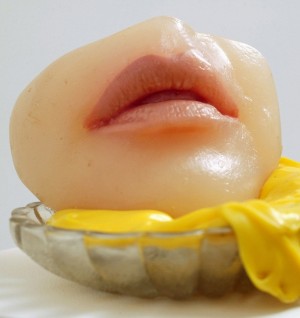Alina Szapocznikow: The Body Artist
One of the most harrowing examples of this dissolution is her Tumors (Tumeurs personnifiees) series of 1971, recalling her body turned against itself by cancer. (Two years earlier, she had been diagnosed with breast cancer.) Utilizing polyester resin, fiberglass, paper and gauze, clusters of cancerous growths are scattered like so many misshapen balls in a playpen. She intended these forms to be placed at floor level. A close inspection reveals her disembodied face peering from within the forms. (Some visitors were obviously stunned by this display, approaching and retreating just as quickly from the exhibit box.) Notable in the curators’ remarks about this work within the catalog is this observation: “…one senses an artist desperate to create, or indeed procreate, form by deploying her own body in the face of its inevitable and rapid decline.”
The use of photos encased in resin (entitled Souvenirs) was an earlier experiment of hers that held sway with many of her celebrity acquaintances and fans of the day, including the likes of Twiggy, Julie Christie, Sophia Loren and Monica Vitti, among others.
Only feet away, are the most darkly theatrical pieces such as Stele (Stèle), portraying a woman who appears to be dissolving within a river of black lava, and Headless Torso (Torse noyé), a bare-breasted, upper female torso that is encased in a similar bed of polyurethane foam.
In her final body of work, the Herbier (Herbarium) series, she created flattened images of herself and her son on wood panels. These are most haunting — their resin portraits appearing like shed skin showing the artist, facing death, at her most vulnerable, as if dissolving into the void. (The name of the series is derived from placing plant pieces into books.) Almost as a footnote, a Christ-like nude sculpture of her son, Piotr, in polyester resin sleeps as if in a Botticelli-induced dream.
Such examples of her three-dimensional output could overshadow the power of her drawings and they might have been better served by being set-off in a space of their own. But the drawings do, in all fairness, serve as a helpful adjunct for the sculptures themselves. It’s a heady and handsomely mounted assortment and thanks are due to Connie Butler, the Robert Lehman Foundation chief curator of drawings since 2006. Some monotypes are as bold as a Rorschach test sample while other ink renderings express the disturbing but delicate eroticism of a Hans Bellmer, a surrealist known for his depictions of truncated mannequins and dolls.
Who was Alina?
To understand the scope of Szapocznikow’s investigations, it’s essential to go back to the beginning. Born to a Jewish family in Poland in 1926, the timing of her birth could have had disastrous consequences. Sent to Bergen-Belsen as a teenager via the Auschwitz camp, she was instead allowed to assist her physician mother during their encampment.
Was it here that the idea of dissembling the human form into disparate parts, the disassociation of patient from practitioner, first took hold? Perhaps we’ll never know. But it is certain that the trauma of those years was irreversible. In a television interview with subtitles from 1966 on a nearby wall monitor, the interviewer Jean-Marie Drot tries to elicit a relationship between the artworks and her concentration camp experience. Resembling a young Ingrid Bergman in her initial openness, she avoids any direct response, mentioning instead a stonecutter friend who said when she improved her sculpture, the sculpture would come by itself. (It is worth listening to a portion of this exchange, albeit in French, to hear her soft, well-modulated voice.)
Immediately following war’s end, she traveled to Prague where she studied sculpture at an industrial arts college before moving to Paris for further schooling at the École des Beaux-Arts. It was there she became associated with Nouveau Réalisme, a proto-Pop movement of French artists. Suffering from tuberculosis, she returned to Poland in 1948, marrying Ryszard Stanislawski, a director of the Museum of Modern Art in Łódź. It was during this period that she adopted a son who would figure in one of her later most poignant sculptures.
Her talent was soon recognized and by 1957, she was given a solo exhibit at Warsaw’s prestigious Zachęta National Gallery of Art. Her appearance at the Venice Biennale of 1962 brought further acclaim. But Paris was the siren in her ear calling her back, and where she remained for the rest of her life. In 1968, the grim reaper of breast cancer entered the stage, and her work and life was irretrievably changed. Her death five years later was a terrible blow not only to Alina, the woman, and those who loved her, but to the body of work this prolific and insatiable artist would inevitably have continued to produce.
It’s not an easy exhibit — and may even repel the faint-hearted — but it’s an important one, worthy of an artist who was willing to risk everything for her art. In her own words: “I am convinced that of all the manifestations of the ephemeral, the human body is the most vulnerable, the only source of all joy, all suffering, and all truth.”
“Alina Szapocznikow, Sculpture Undone, 1955-1972” is currently on exhibit at The Museum of Modern Art, 11 West 53 Street, New York, NY 10019-54971955-1972 and will run through January 28, 2013. For more information please visit www.moma.org or call (212) 708-9400.


